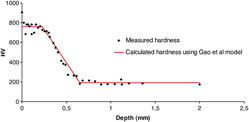Crossref Citations
This article has been cited by the following publications. This list is generated based on data provided by
Crossref.
Moussa, Charbel
Bartier, Olivier
Mauvoisin, Gérard
Hernot, Xavier
Collin, Jean-Marc
and
Delattre, Guillaume
2014.
Experimental and numerical investigation on carbonitrided steel characterization with spherical indentation.
Surface and Coatings Technology,
Vol. 258,
Issue. ,
p.
782.
Moussa, Charbel
Hernot, Xavier
Bartier, Olivier
Delattre, Guillaume
and
Mauvoisin, Gérard
2014.
Evaluation of the tensile properties of a material through spherical indentation: definition of an average representative strain and a confidence domain.
Journal of Materials Science,
Vol. 49,
Issue. 2,
p.
592.
Araújo, Rodrigo
and
Dias, Avelino Manuel da Silva
2014.
Numerical Evaluation of Strength in the Interface during Indentation Spherical Testing in Thin Films.
Materials Sciences and Applications,
Vol. 05,
Issue. 03,
p.
149.
Moussa, Charbel
Hernot, Xavier
Bartier, Olivier
Delattre, Guillaume
and
Mauvoisin, Gérard
2014.
Identification of the hardening law of materials with spherical indentation using the average representative strain for several penetration depths.
Materials Science and Engineering: A,
Vol. 606,
Issue. ,
p.
409.
Vinogradov, V.
Knyazhansky, M.
and
Tsun, A.
2015.
Experimental observation and numerical modeling of formation of local plastic zones in hardened surface layers due to contact overloading.
Mechanics of Materials,
Vol. 83,
Issue. ,
p.
90.
Lee, Po-Hua
and
Yin, Huiming
2015.
Size Effect on Functionally Graded Material Fabrication by Sedimentation.
Journal of Nanomechanics and Micromechanics,
Vol. 5,
Issue. 2,
Marteau, J.
Bouvier, S.
and
Bigerelle, M.
2015.
Review on Numerical Modeling of Instrumented Indentation Tests for Elastoplastic Material Behavior Identification.
Archives of Computational Methods in Engineering,
Vol. 22,
Issue. 4,
p.
577.
Moussa, Charbel
Bartier, Olivier
Hernot, Xavier
Mauvoisin, Gérard
Collin, Jean-Marc
and
Delattre, Guillaume
2016.
Mechanical characterization of carbonitrided steel with spherical indentation using the average representative strain.
Materials & Design,
Vol. 89,
Issue. ,
p.
1191.
Libório, Maxwell Santana
Dias, Avelino Manuel da Silva
and
Souza, Roberto Martins
2017.
Determination of Film Thickness Through Simulation of Vickers Hardness Testing.
Materials Research,
Vol. 20,
Issue. 3,
p.
755.
Dias, Avelino Manuel da Silva
Silva, Everton Carneiro da
and
Libório, Maxwell Santana
2019.
Experimental-numerical Technique to Evaluate the Thickness of TiN Thin Film.
Materials Research,
Vol. 22,
Issue. 5,
Alaboodi, Abdulaziz S.
and
Hussain, Zahid
2019.
Finite element modeling of nano-indentation technique to characterize thin film coatings.
Journal of King Saud University - Engineering Sciences,
Vol. 31,
Issue. 1,
p.
61.
Wang, Mingzhi
and
Wu, Jianjun
2019.
Identification of plastic properties of metal materials using spherical indentation experiment and Bayesian model updating approach.
International Journal of Mechanical Sciences,
Vol. 151,
Issue. ,
p.
733.
Chen, Hui
and
Cai, Li-xun
2019.
A universal elastic-plastic model correlating load-displacement relation and constitutive parameters for typical testing components.
Results in Physics,
Vol. 13,
Issue. ,
p.
102230.
Javaheri, Ehsan
Kumala, Verdiana
Javaheri, Alireza
Rawassizadeh, Reza
Lubritz, Janot
Graf, Benjamin
and
Rethmeier, Michael
2020.
Quantifying Mechanical Properties of Automotive Steels with Deep Learning Based Computer Vision Algorithms.
Metals,
Vol. 10,
Issue. 2,
p.
163.
Xu, GuangTao
Hao, MengFei
Qiao, YinKui
Zhang, YuFang
Wang, Gang
and
Zhao, MingHao
2020.
Characterization of elastic-plastic properties of surface-modified layers introduced by carburizing.
Mechanics of Materials,
Vol. 144,
Issue. ,
p.
103364.
Liu, Haiting
Ma, Jiawei
Tang, Ao
Tang, Jingzhao
Zhang, Chonghong
Zhang, Lei
and
Shen, Yao
2020.
True stress-strain curve extraction from ion-irradiated materials via small tensile, small punch and nanoindentation tests: method development and accuracy/consistency verification.
Nuclear Fusion,
Vol. 60,
Issue. 5,
p.
056012.
Heydari Astaraee, Asghar
Bagherifard, Sara
Bradanini, Andrea
Duó, Pierangelo
Henze, Steffen
Taylor, Benjamin
and
Guagliano, Mario
2020.
Application of shot peening to case-hardened steel gears: the effect of gradient material properties and component geometry.
Surface and Coatings Technology,
Vol. 398,
Issue. ,
p.
126084.
Han, Guangzhao
Cai, Lixun
Huang, Maobo
and
Liu, Xiaokun
2021.
Analytical elastoplastic model for stress and strain of the equivalent representative volume element and material testing application.
Materials & Design,
Vol. 212,
Issue. ,
p.
110217.
Xu, GuangTao
Sun, Bo
Qiao, YinKui
Wang, Gang
and
Zhao, MingHao
2021.
Characterization of the plasticity parameters of the surface-modified layer of 18CrNiMo7-6 alloy steel after carburizing heat treatment through the indentation method.
Journal of Materials Research and Technology,
Vol. 12,
Issue. ,
p.
2307.
Gao, Jie
Zheng, Ke
Yu, Shengwang
Hei, Hongjun
Wu, Yanxia
Gong, Huarong
and
Ma, Yong
2022.
Characterization of Quasi-Static/Dynamic Contact Mechanical Properties of Mo Surface-Modified TC4.
Coatings,
Vol. 12,
Issue. 2,
p.
123.





